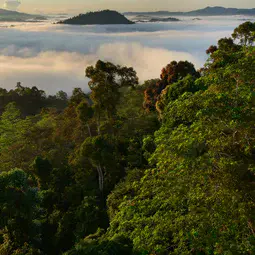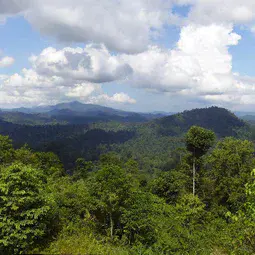Travelling pollution – East Asian human activities affect air quality in remote tropical forests
Researchers from the UK and Malaysia have detected a human fingerprint deep in the Borneo rainforest in Southeast Asia. Cold winds blowing from the north carry industrial pollutants from East Asia to the equator, with implications for air quality in the region. Once there, the pollutants can travel higher into the atmosphere and impact the ozone layer. The research is published today in Atmospheric Chemistry and Physics, an open access journal of the European Geosciences Union (EGU).
Rainforests are often associated with pure, unpolluted air, but in Borneo air quality is very much dependent on which way the wind blows. “On several occasions during northern-hemisphere winter, pockets of cold air can move quickly southwards across Asia towards south China and onward into the South China Sea,” says Matthew Ashfold, Assistant Professor at the University of Nottingham Malaysia Campus.
In a new study, Ashfold and his team show that these ‘cold surges’ can very quickly transport polluted air from countries such as China to remote parts of equatorial Southeast Asia. “The pollution travels about 1000 km per day, crossing the South China Sea in just a couple of days,” states Ashfold, who was based at the University of Cambridge, UK, when he conducted parts of the study.
The researchers were initially looking for chemical compounds of natural origin: they wanted to test whether the oceans around Borneo were a source of bromine and chlorine. They designed their experiments to measure these gases, but also detected another gas called perchloroethene, or perc, in the air samples they collected from two locations in the Borneo rainforest. “This gas is a common ‘marker’ for pollution because it does not have natural sources,” says Ashfold.
The team wanted to find out where the man-made gas came from, and where it might go. “We used a UK Met Office computer model of atmospheric transport to look back in time, at where the air samples we collected had travelled from.” Their experiments suggested the high levels of perc in the air samples were influenced by East Asian pollution, as reported in the Atmospheric Chemistry and Physics study.
Perc is produced in a number of industrial and commercial activities, such as dry cleaning and metal degreasing, and exposure to large amounts (above about 100 parts per million) can affect human health. While global emissions of perc have declined in the past 20 years or so, it is not clear whether this has been the case in East Asia, where air pollution has increased over the past couple of decades.
The researchers say the levels of perc measured in Borneo are low, at a few parts per trillion. But because the gas does not occur naturally, even small concentrations are a sign that other more common pollutants, such as carbon monoxide and ozone, could be present. Ozone, for example, can damage forests when in high concentrations, as it reduces plant growth.
Indeed, the team’s measurements showed the amounts of perc varied strongly over the course of about a week, and models they analysed indicated this variation to be related to similar changes in carbon monoxide and ozone. “During the one ‘cold surge’ event we studied in detail, levels of these pollutants over Borneo appeared to be double typical levels,” Ashfold points out.
But diminished air quality in the remote rainforest is not the only way East Asia pollution affects the tropics. “The atmosphere over Southeast Asia and the Western Pacific is home to unusually strong and deep thunderstorms during the northern hemisphere winter. Because of this, the region is an important source of air for the stratosphere,” says Ashfold.
In their study the researchers show that, once in the deep tropics, the polluted air is lifted towards the upper atmosphere. “This can introduce a range of industrial chemicals with atmospheric lifetimes of just a few months to the stratosphere, which could have a potentially negative impact on the ozone layer.”
###
Please mention the name of the publication (Atmospheric Chemistry and Physics) if reporting on this story and, if reporting online, include a link to the paper (http://www.atmos-chem-phys.net/15/3565/2015/acp-15-3565-2015.html) or to the journal website (http://www.atmospheric-chemistry-and-physics.net).
More information
This research is presented in the paper ‘Rapid transport of East Asian pollution to the deep tropics’ published in the EGU open access journal Atmospheric Chemistry and Physics on 31 March 2015.
Citation: Ashfold, M. J., Pyle, J. A., Robinson, A. D., Meneguz, E., Nadzir, M. S. M., Phang, S. M., Samah, A. A., Ong, S., Ung, H. E., Peng, L. K., Yong, S. E., and Harris, N. R. P.: Rapid transport of East Asian pollution to the deep tropics, Atmos. Chem. Phys., 15, 3565-3573, doi:10.5194/acp-15-3565-2015, 2015.
The team is composed of M. J. Ashfold (Department of Chemistry, University of Cambridge, UK [Ch. Cam.], now at School of Biosciences, University of Nottingham Malaysia Campus, Semenyih, Malaysia), J. A. Pyle (Ch. Cam. and National Centre for Atmospheric Sciences, UK), A. D. Robinson (Ch. Cam.), E. Meneguz (UK Met Office, Exeter, UK), M. S. M. Nadzir (Universiti Kebangsaan Malaysia, Bangi, Malaysia and Institute of Ocean and Earth Sciences, University of Malaysia, Kuala Lumpur [IOES]), S. M. Phang and A. A. Samah (IOES), S. Ong and H. E. Ung (Global Satria Life Sciences Lab, Tawau, Malaysia), L. K. Peng and S. E. Yong (Malaysian Meteorological Department, Lahad Datu, Malaysia), and N. R. P. Harris (Ch. Cam.).
The European Geosciences Union (EGU) is Europe’s premier geosciences union, dedicated to the pursuit of excellence in the Earth, planetary, and space sciences for the benefit of humanity, worldwide. It is a non-profit interdisciplinary learned association of scientists founded in 2002. The EGU has a current portfolio of 17 diverse scientific journals, which use an innovative open access format, and organises a number of topical meetings, and education and outreach activities. Its annual General Assembly is the largest and most prominent European geosciences event, attracting over 11,000 scientists from all over the world. The meeting’s sessions cover a wide range of topics, including volcanology, planetary exploration, the Earth’s internal structure and atmosphere, climate, energy, and resources. The EGU 2015 General Assembly is taking place in Vienna, Austria, from 12 to 17 April 2015. For information about meeting and press registration, please check http://media.egu.eu or follow the EGU on Twitter and Facebook.
If you wish to receive our press releases via email, please use the Press Release Subscription Form at http://www.egu.eu/news/subscribe/. Subscribed journalists and other members of the media receive EGU press releases under embargo (if applicable) 24 hours in advance of public dissemination.
Contact
Matthew Ashfold
Assistant Professor at School of Biosciences, University of Nottingham Malaysia Campus
Jalan Broga, Semenyih
Selangor, Malaysia
Phone+6 (03) 8725 3434
Emailmatthew.ashfold@nottingham.edu.my
John Pyle
Professor at the Department of Chemistry, University of Cambridge
Cambridge, UK
Phone+44 (0) 1223 336473
Emailjohn.pyle@atm.ch.cam.ac.uk
Neil Harris
Lecturer at the Department of Chemistry, University of Cambridge
Cambridge, UK
Phone+44 (0) 1223 763816 (shared)
EmailNeil.Harris@ozone-sec.ch.cam.ac.uk
Bárbara Ferreira
EGU Media and Communications Manager
Munich, Germany
Phone+49 (0) 89 2180 6703
Emailmedia@egu.eu
Links
- Scientific paper
- Journal – Atmospheric Chemistry and Physics
- Read this press release in simplified language, aimed at 7–13 year olds, on our Planet Press site



